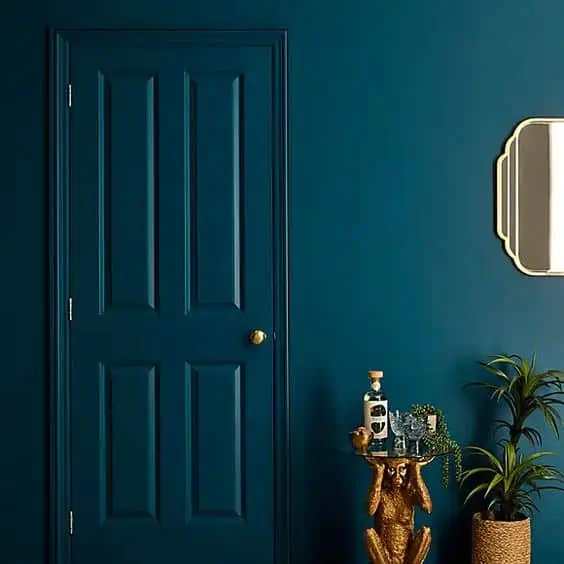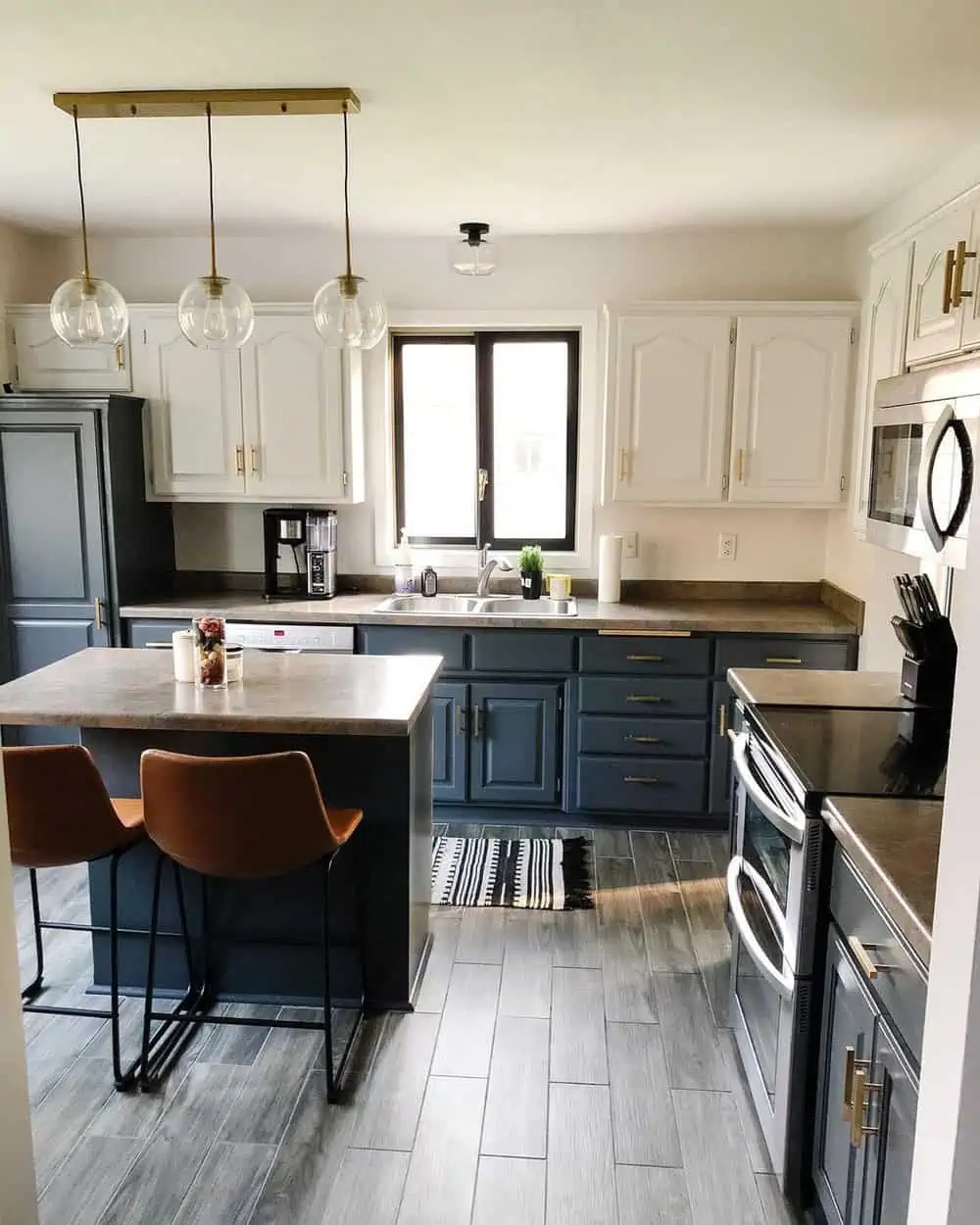Are you tired of that huge blotch of mold on your wall? It could be affecting your health. These microorganisms can disrupt your peace and wellbeing and even cause damage to your home.
As the name suggests, mold and mildew-resistant paints are made with antimicrobial substances. These prevent mold and mildew from growing and spreading. It’s an efficient way of addressing this common problem.
But how do you decide which is the best mold-killing primer to buy, and what are your options?
We’ve spent hours researching real customer reviews, various products, and expert advice. We analyzed how the paint works, what it’s best for, and the various finishes. To conclude, we’ve rounded up the five best mold and mildew-resistant paints to protect your home.

- For indoors and outdoors
- Creates a waterproof barrier
- Low odor

- Mold resistance lasts 5 years
- Moisture-repellent
- Large coverage area

- Low odor
- Doubles as a finisher
- Large coverage area

- Self-priming
- Available in many colors
- Large coverage area

- Lifetime waterproof guarantee
- Self-priming
- Duration of five years
Review Methodology: At Oh So Spotless, we strive to provide you with the most accurate and reliable information when it comes to choosing the best mold and mildew resistant paints. Our team of professionals conducts thorough research, data analysis, and hands-on testing to evaluate each product based on essential criteria such as performance, durability, and user experience. We compare and rank products based on these factors, ensuring we present you with the top selections. By sharing our findings and quantitative measurements, we help you make informed decisions, taking into account key factors like effectiveness, ease of application, and coverage. Our experts also delve into the design choices and their impact on users, offering first-hand evidence to back up our recommendations, and ensuring you find the best mold and mildew resistant paint for your needs.
The Best Mold and Mildew Resistant Paints of 2024
We’ve researched the best products on the market and read in-depth product reviews from clients who’ve used them. We’ve chosen the most efficient to best help protect your home. Here are the five best mold and mildew-resistant paints.
Kilz Interior/Exterior Basement and Masonry Waterproofing Paint
Best for Wet Areas
This Kilz paint can be used indoors and outdoors, specifically in wet areas like kitchens and bathrooms. The fantastic formula is waterproof and will seal any porous surfaces in your home.
This mold and mildew-resistant paint uses nanotechnology, allowing the paint to form a barrier that stops water infiltration. It’s great for prepping wet places in the home. However, you shouldn’t use it on surfaces with active water leaks.
Its alkali-resistant coating provides you with a long-lasting, decorative and durable finish. You can use this paint on basement walls, masonry walls, concrete blocks, and brick.
Pros
- Great for indoors and outdoors areas.
- Creates a waterproof barrier and seals surfaces.
- Easily applied with a brush, roller, or sprayer.
- Low odor formula is less irritating.
- Prevents mildew from forming, so you’re more protected.
Cons
- It’s not suitable for floors.
- You still need to apply a primer for uncoated, patched, wood, and metal surfaces.
Product Specs
| Primer Required? | Yes |
| Coverage | 75 to 125 square feet per gallon |
| Size | One gallon |
| Finish | Flat |
| Base | Water-based |
Our Ratings
User Experience
Rust-Oleum Perma-White Mold and Mildew Proof Interior Paint
Best Mold Resistant Self Primer
This is a high-performance mold-resistant paint with a low odor coating. It’s great for high moisture areas, such as garages, bathrooms, and basements.
The paint’s resistance to mold and mildew comes with a five-year guarantee. So you can rest easy knowing your surfaces are safe for a while. Plus, the water-based paint has a washable, moisture-resistant finish and a coverage area of 400 square feet per gallon.
It’s available in a white semi-gloss color. The paint is tintable to off-white, pastel, and medium colors.
It’s also a self-priming paint and sticks on the surface without needing a primer. The self-priming feature isn’t as effective as other mold-resistant paints, but it’s a bonus.
Pros
- Mold resistance feature lasts five years.
- Self-priming paint means you can skip a step.
- Large 400 square feet coverage area.
- Moisture-repellent, making it a great option for kitchens and bathrooms.
- Semigloss finish is durable and aesthetic.
Cons
- Mild ammonia smell may last a few days.
- The self-priming feature isn’t as good as some other products.
- It requires about three coats to look good.
Product Specs
| Primer Required? | No |
| Coverage | 400 square feet per gallon |
| Size | One gallon |
| Finish | Semi-gloss |
| Base | Water-based |
Our Ratings
Personal Perspective
Fiberlock - Aftershock - EPA Registered Fungicidal Coating
Best for Interiors
This paint is an EPA-registered fungicidal coating sure to kill mold and mildew and prevent future growth in your home.
Fiberlock Aftershock is an acrylic sealant making it very durable. You can use it on plaster, drywall, metal, and many other surfaces. It’s a great option for interiors, including any room, wooden furniture, and concrete.
Once applied, this paint has a 10-year warranty, so you can rest easy that it will do its job for years to come.
Pros
- Antimicrobial features will kill existing mold and mildew.
- This paint prevents mold and mildew growth.
- It’s very durable and a great choice for high-traffic homes.
- It’s easy to apply.
- Comes with a 10-year warranty.
- It’s suitable for most surfaces in most areas of the home.
Cons
- The odor is irritating for some customers.
- It is extremely expensive.
- It doesn’t hide cracks and imperfections.
Product Specs
| Primer Required? | No |
| Coverage | 150 to 400 square feet per gallon |
| Size | One gallon |
| Finish | Semi-gloss |
| Base | Water-based |
Our Ratings
Community Feedback
Kilz Masonry, Stucco and Brick Paint
Best Paint for All Surfaces
KILZ Masonry, Stucco, and Brick flat paint offer nothing less than high quality. The acrylic latex paint provides excellent hiding abilities, making it superb for interior and exterior surfaces. It’s also an excellent mold and mildew-resistant paint.
It’s self-priming, provides an excellent grip, and has outstanding water repellency. The formula works properly on prepared/smooth or rough/textured masonry, stucco and brick surfaces.
This paint is available in premixed colors other than white, such as gray and tan.
Pros
- Self-priming, so you can skip a step.
- Available in many colors.
- Large coverage area of up to 400 square feet.
- Durable satin finish that works in various areas of the home.
- It’s easy to clean if you get marks or stains on the paint.
- Low VOC formula is better for your health.
Cons
- It’s not suitable for flooring.
- You may need to apply a few coats.
Product Specs
| Primer Required? | No |
| Coverage | 250 to 400 square feet per gallon |
| Size | One gallon |
| Finish | Flat |
| Base | Water-based |
Our Ratings
First-Hand Impression
Rust-Oleum Watertite 5001
Best for Exterior
Slightly different from other Rust-Oleum products, this paint is oil-based and has a lower odor than standard latex paints.
It contains antimicrobial agents. These guarantee no growth or spread of mold and mildew for the next five years.
Watertite paint is guaranteed to act as a barrier against up to 34 PSI of water pressure. This means it has twice the strength of conventional waterproof paints. It can be used inside or outside, on wet or dry walls.
Pros
- Twice the strength of other waterproof paint.
- Self-priming so you can skip a step.
- Long-lasting mold prevention of five years.
- Can withstand up to 34 PSI of after pressure.
- Suitable for indoor and outdoor use.
Cons
- Oil-based, so it’s not eco-friendly.
- Customers found that water managed to leak or seep through the paint.
Product Specs
| Primer Required? | No |
| Coverage | 75 to 125 square feet per gallon |
| Size | One gallon |
| Finish | Flat |
| Base | Oil-based |
Our Ratings
User Experience
| Product | Best | Need Primer | Coverage | Size | Finish | Base |
|---|---|---|---|---|---|---|
| Kilz Interior/Exterior Paint | For Wet Areas | Yes | 75 – 125 sq ft / gal | One gal | Flat | Water |
| Rust-Oleum Perma-White Paint | Mold Resistant Self Primer | No | 400 sq ft / gal | One gal | Semi-gloss | Water |
| Fiberlock-Aftershock Fungicidal Coating | For Interiors | No | 150 – 400 sq ft / gal | One gal | Semi-gloss | Water |
| Kilz Masonry, Stucco & Brick Paint | Paint for All Surfaces | No | 250 – 400 sq ft / gal | One gal | Flat | Water |
| Rust-Oleum Watertite 5001 | For Exterior | No | 75 – 125 sq ft / gal | One gal | Flat | Oil |
Mold and Mildew Resistant Paint Finish Options
Mold and mildew-resistant paints are available in different types of finishes. Let’s take a look at the options available and their ideal surfaces:
Matte (Flat)
- Price: 4/5
- Usability: 3/5
With zero to 10 percent gloss, a matte (or flat) finish offers no reflectivity of light. This makes it unsuitable for places that receive little natural light. It’s more suited, instead, for hiding imperfections such as cracks and patches.
Being the least durable of all finishes, it’s also difficult to clean (1). Therefore, it works well on areas such as ceilings since no one touches the ceiling.
We’d recommend it for homes without young children or pets. It’s also not the best paint for the toilet or bathroom because of its low water resistance.
Pros
- It hides imperfections and cracks.
- It’s an excellent option for living spaces.
- It’s suitable for ceilings.
- It provides a clean and non-reflective finish.
Cons
- It’s not as durable in high-traffic areas.
- It’s difficult to clean, which makes it an unsuitable option for homes with children and pets.
- It doesn’t have good water resistance.
Eggshell
- Price: 4/5
- Usability: 4/5
Like matte, eggshell has a low reflective sheen with a 10 to 25 percent gloss composition. We recommend it for rustic-style walls or for adding a vintage touch to wooden furniture.
Due to the sheen, you might love that it makes a room look a little bigger than it actually is.
It’s also slightly more durable and provides more protection than matte. It’s easier to clean as well. One drawback is that it can make cracks or imperfections more noticeable.
Pros
- It has a subtle glossy finish.
- It can help make a home look more vintage.
- It can make a room look bigger.
- It’s more durable and water resistant.
- It’s pretty easy to clean.
Cons
- It can highlight cracks and imperfections.
- It’s hard to touch up and paint over parts as this will add more gloss.
Satin
- Price: 3/5
- Usability: 4/5
Often categorized alongside eggshell because of its slight luster, satin offers more durability and features about 25 to 35 percent gloss.
Since it’s more durable and easier to clean, it sort of fits into the role of middle ground. It offers just a slight gloss. But at the same time, it provides the same uses as eggshell or matte finishes.
Satin paint works well in high-traffic rooms and can even be used outdoors. However, it doesn’t hide imperfections as well as matte or eggshell.
Pros
- It has a noticeable gloss which some people love.
- It’s very durable.
- It’s easy to clean.
- You can use it in pretty much any room of the house, including outdoors.
Cons
- It might be more expensive and harder to find.
- It doesn’t hide imperfections well.
Low or Semi-Gloss
- Price: 3/5
- Usability: 4/5
This popular coat is suitable for rooms with high and low moisture levels. With 35 to 70 percent gloss, it offers drastically more light reflectivity than satin. However, because of its high reflectivity, it cannot hide imperfections on the wall.
It’s very durable, making it ideal for rooms with lots of activity and traffic. You can use it both indoors and outdoors. As it’s very easy to clean, you can use satin paint in the bathroom, toilet, and kitchen.
Pros
- Great for kitchens and bathrooms since it’s moisture resistant.
- Semi-glossy, giving it a lovely sheen.
- Very durable, making it great for homes with kids and pets.
- Suitable for indoor and outdoor use.
- You can clean it easily.
Cons
- It doesn’t hide imperfections or cracks at all.
- It’s a bit harder to apply.
- You will need to do three coats sometimes.
High Gloss
- Price: 3/5
- Usability: 3/5
With 70 to 100 percent gloss, high gloss is the most durable and reflective coat.
It’s the easiest to clean, and you can apply it anywhere, including in high-traffic areas. High gloss paint is perfect for door trims, woodwork, molding, cabinets, kitchens, bathrooms, and even outdoors.
With zero imperfection-hiding qualities, however, it would be difficult to apply by oneself. So, we’d recommend using a professional.
Pros
- It’s very durable, making it ideal for busy homes.
- It’s super easy to clean.
- You can apply it anywhere, including indoors and outdoors.
- Gives a lacquer finish but is cheaper than lacquer.
Cons
- It’s a bit more expensive than other kinds of paint.
- You will need a professional painter to apply it.
- It can take six to seven strokes to apply it evenly.
- It doesn’t hide imperfections or cracks on your wall.
Selecting the Best Mold and Mildew Resistant Paints
We have come up with a list of features to check for when choosing mold and mildew-resistant paints. That way, you can make a decision that suits your needs.





















